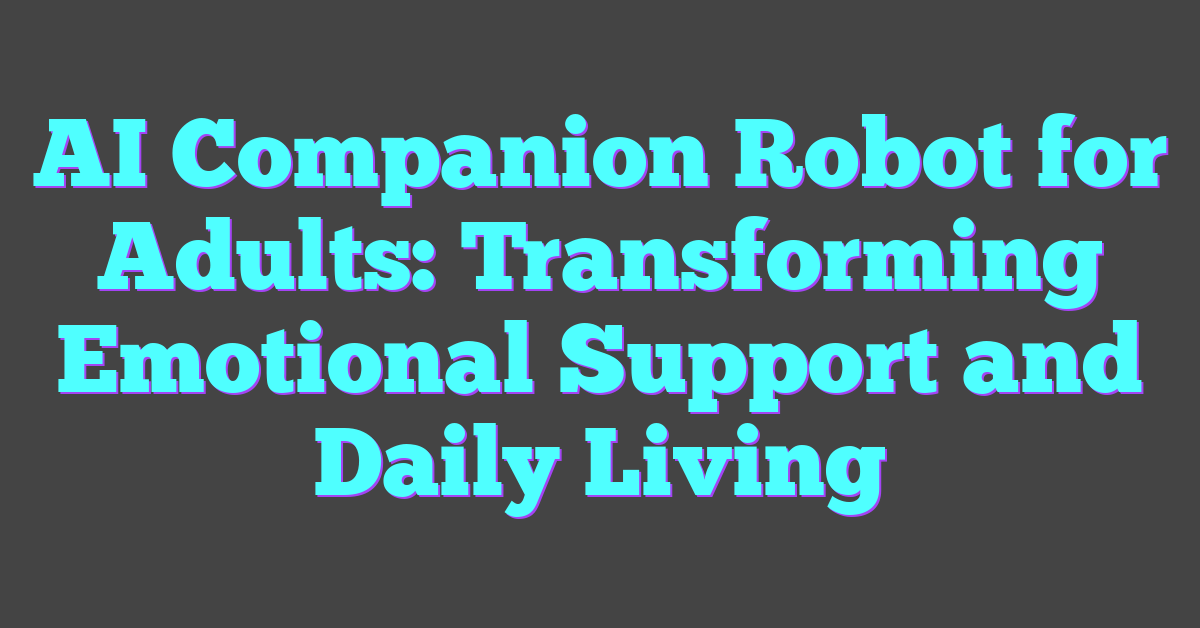Imagine coming home after a long day to a friendly face that’s always there to greet you. AI companion robots for adults are transforming how people experience companionship and support in their daily lives. These intelligent machines offer more than just conversation; they provide emotional support, help with tasks, and even keep you entertained.
As technology advances, AI companion robots are becoming more sophisticated and lifelike. They can learn your preferences, adapt to your routines, and offer personalized interactions that feel genuinely human. Whether you live alone or just need an extra hand, these robots can make a significant difference in your quality of life.
The Emergence of AI Companion Robots for Adults
AI companion robots have garnered attention for their ability to provide support and companionship. As technology improves, these robots are becoming essential in modern life.

The Need for AI Companionship in Modern Times
Modern society often faces challenges related to isolation and loneliness. Increasing urbanization, aging populations, and demanding work schedules contribute to this trend. AI companion robots can fill the void by offering interactive and responsive companionship. According to a 2020 study by AARP, more than one-third of adults aged 50 and older report feelings of loneliness. These figures highlight the necessity of AI companions for emotional and social support.
The Evolution of AI Technology in Robotics
AI technology has advanced remarkably, enhancing the capabilities of companion robots. Initially, robots featured rudimentary interaction abilities. Now, they utilize complex machine learning algorithms to adapt to individual user preferences. Natural Language Processing (NLP) allows robots to understand and respond to human speech more naturally. Features such as facial recognition and emotional analytics enable these robots to gauge user emotions and respond appropriately, increasing their lifelikeness.
Developments in AI have also led to more autonomous robots. Notably, these machines can learn from user interactions, improving their responses over time. Studies in AI and robotics indicate that continuous interaction allows these robots to offer increasingly personalized experiences, enhancing user satisfaction.
AI companion robots integrate seamlessly into users’ daily routines, providing reminders and assistance with tasks. As technology progresses, these robots are expected to become even more indistinguishable from human interaction partners.
By optimizing these sections, the article maintains a natural flow from discussing the impact of AI companion robots on emotional support and daily assistance to exploring the societal need for these technologies and their technological advancements, ultimately reinforcing the article’s primary themes.
Key Features of AI Companion Robots
AI companion robots leverage advanced machine learning and AI technologies to enhance user experience. Key features focus on emotional intelligence and daily assistance.
Emotional Intelligence Capabilities
AI companion robots now possess advanced emotional intelligence capabilities, allowing them to recognize and respond to human emotions accurately. They use machine learning algorithms to analyze speech patterns, facial expressions, and body language. These robots adapt their responses based on detected emotional cues, offering empathy and appropriate reactions. For example, if a user feels sad, the robot might suggest uplifting activities or offer comforting words. This emotional intelligence helps create a more personalized and meaningful interaction for users.
Automation and Daily Assistance
AI companion robots also offer practical benefits by automating various daily tasks. They can manage schedules, set reminders for medications, and even control smart home devices, enhancing convenience for users. Through natural language processing, users can issue voice commands to the robot, streamlining interaction. For instance, a user can ask the robot to adjust the thermostat, turn off lights, or play a favorite playlist. This integration of automation not only eases daily routines but also supports independent living, particularly for older adults.
Benefits of AI Companion Robots for Adults
AI companion robots bring numerous advantages to adults, offering both social and practical support.
Enhancing Social Interaction
AI companion robots enhance social interaction by providing constant companionship and engaging conversations. These robots use advanced natural language processing (NLP) to understand and respond to diverse communication styles, enabling meaningful dialogues. They can simulate real human interactions, reducing feelings of loneliness and isolation. AI-driven robots can also connect individuals to wider social networks by suggesting interests and hobbies, acting as social bridges.
Providing Assistance and Safety
These robots also provide essential assistance and safety features. They aid in managing daily tasks like setting reminders, controlling smart home devices, and tracking medications. With machine learning capabilities, they adapt to the routines and preferences of their users. For safety, AI robots can detect emergencies like falls or health anomalies using sensors and alert systems, ensuring rapid response. This makes them invaluable for older adults who live independently but require reliable support.
Challenges and Considerations
AI companion robots bring numerous benefits but also face several challenges. Decision-makers should consider ethical implications and integration into daily life.
Ethical Implications
Ethical concerns arise as AI companion robots interact closely with humans. Privacy issues need addressing since these robots collect sensitive data, such as health metrics and personal preferences. If data breaches occur, users may face significant risks. Transparency in data usage and adherence to stringent data protection regulations are crucial.
Bias in AI algorithms presents another ethical challenge. Companion robots use machine learning models trained on diverse datasets. However, if these datasets aren’t representative, biased interactions may occur. Regular audits and updates to datasets and algorithms help mitigate this risk.
The emotional dependency on AI robots raises ethical questions. Users, especially the elderly or emotionally vulnerable, might form deep attachments to these robots. This dependency could impact their interaction with real humans. Designers must balance creating emotionally supportive interactions without fostering unhealthy dependencies.
Integration into Daily Life
Seamless integration into daily life remains a challenge for AI companion robots. Compatibility with existing smart home systems and devices is essential for smooth operation. If these robots fail to interact properly with other devices, user experience suffers.
The complexity of human behavior and preferences also poses integration challenges. Machine learning algorithms need constant refinement to adapt to varied daily routines. Personalization features must evolve to cater to individual needs while maintaining ease of use.
Physical space considerations are important. AI robots should fit into users’ homes without causing disruptions. Compact designs and intuitive navigation mechanisms enhance compatibility with different living environments.
Battery life and maintenance are practical concerns. Frequent charging and upkeep can interfere with users’ routines. Innovations in battery technology and self-maintenance capabilities are key to improving user satisfaction.
Integrating AI companion robots into daily life involves a blend of technological compatibility, personalization, and practical considerations. Overcoming these integration challenges ensures that these advanced companions provide seamless and valuable support.
Conclusion
AI companion robots for adults represent a promising blend of technology and empathy. They offer emotional support, practical assistance, and a new level of interaction that can transform daily life. While there are challenges to overcome, the potential benefits are immense.
These robots can significantly enhance the quality of life for many, particularly older adults seeking independence. As technology continues to evolve, addressing ethical and practical concerns will be key to ensuring these companions become a seamless part of everyday living.
Embracing AI companion robots could lead to a future where technology not only makes life easier but also more connected and fulfilling.
Frequently Asked Questions
What are AI companion robots for adults?
AI companion robots are advanced robots designed to offer emotional support, companionship, and assist with daily tasks. They use technologies like machine learning and emotional analytics to recognize and respond to human emotions.
How do AI companion robots help with daily tasks?
These robots can streamline activities such as scheduling, home automation, and reminders, making everyday tasks more manageable for users.
Are AI companion robots suitable for older adults?
Yes, AI companion robots are particularly beneficial for older adults, as they can enhance social interaction, reduce loneliness, and provide practical assistance, supporting independent living.
What technologies do AI companion robots utilize?
AI companion robots primarily use machine learning and emotional analytics to understand and respond to human emotions. They may also integrate with smart home systems for broader functionality.
Are there any ethical concerns with AI companion robots?
Yes, ethical issues include privacy concerns, bias in AI algorithms, and potential emotional dependency on robots. These challenges need to be carefully managed.
How do AI companion robots integrate with smart home systems?
AI companion robots can connect with smart home devices to control various aspects of the home environment, such as lighting, temperature, and security, enhancing their utility.
What are the main challenges in using AI companion robots?
Key challenges include ensuring privacy, eliminating bias in AI algorithms, managing emotional dependency, and addressing battery life and maintenance concerns.
How can AI companion robots alleviate loneliness?
By providing consistent social interaction and emotional support, AI companion robots can significantly reduce feelings of loneliness, especially in older adults.
Are there battery life and maintenance concerns with AI companion robots?
Yes, battery life and maintenance are important considerations. Ensuring long battery life and minimal maintenance requirements can enhance the overall user experience.
Do AI companion robots fit into diverse routines and living spaces?
Yes, these robots are designed to adapt to various daily routines and integrate seamlessly into different living environments, making them versatile for many users.




